How to wallpaper a small bathroom for long-lasting results: 8 steps to success
See the best way to wallpaper a small bathroom, as approved by DIY experts
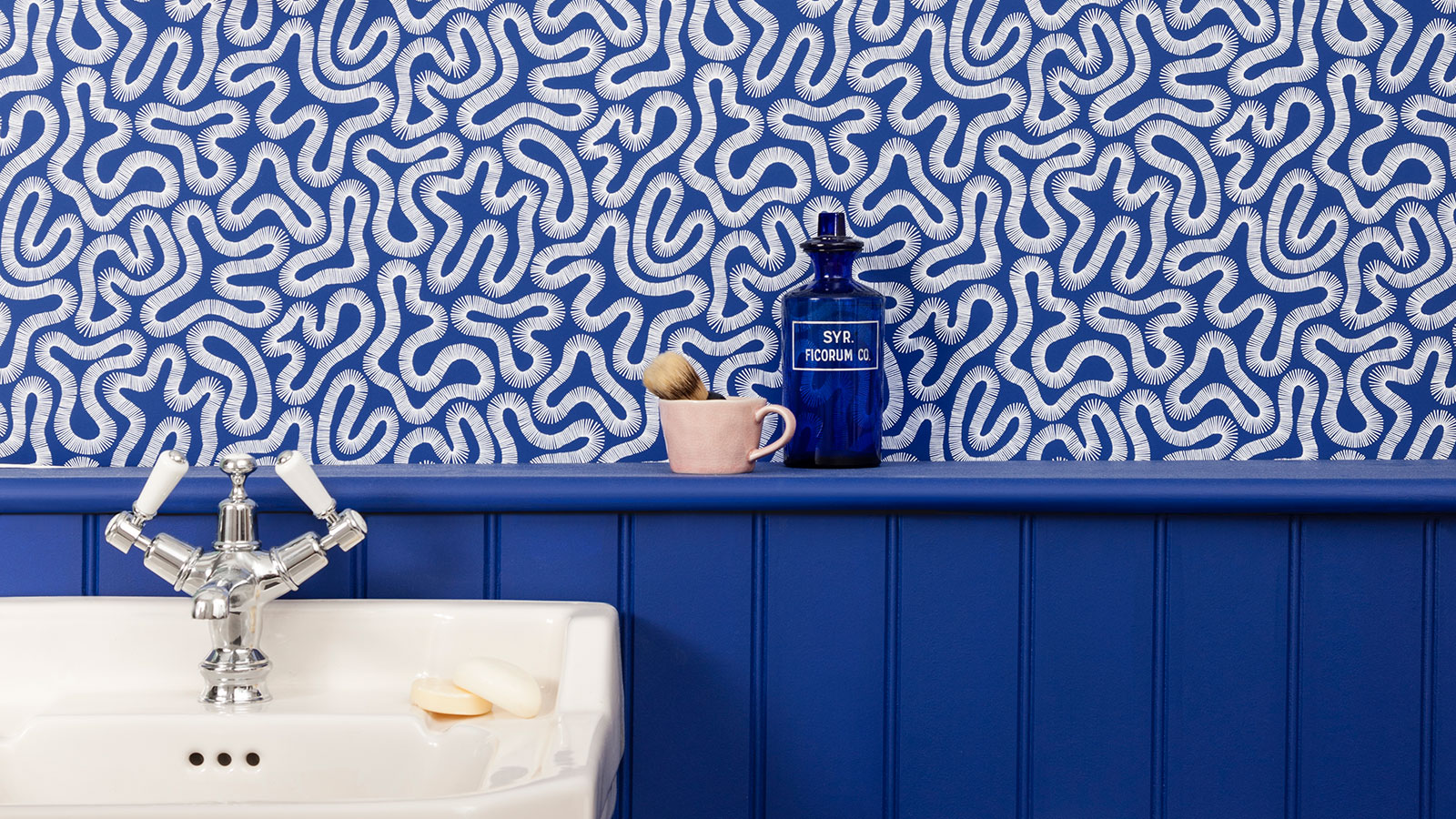
- Paste the wall vs paper
- Shopping list
- 1. Prep the walls
- Step 2: Apply a primer
- Step 3: Measure and cut your wallpaper
- Step 4: Mark your starting point
- Step 5: Hang your wallpaper
- Step 6: Work around the corners
- Step 7: Trim the top and bottom of the paper
- Step 8: Finish up
- What to shop
- What type of wallpaper is best for a bathroom?
- How do you prevent bathroom wallpaper from peeling?
- Should you seal bathroom wallpaper?
- What wallpaper makes a small bathroom look bigger?
- Meet the experts
Getting to grips with how to wallpaper a small bathroom will help avoid all kinds of frustrating hold-ups and ensure your petit space looks perfectly papered in no time at all.
In this guide, our experts reveal the materials and tools you need for the job, run down the process in eight steps, and answer commonly asked questions including whether you should paste the wall, or the wallpaper and more.
Any kind of DIY small bathroom idea requires careful thought in practical terms as it can be harder to carry out any kind of creative task when confined to a compact space. Fear not though, armed with our tips and advice, you can expect this to be a stress-free project with brilliant results.
How to wallpaper a small bathroom for professional results
Bringing in a bathroom trend might present a few additional challenges, especially when it comes to wallpapering compact areas, but there is no reason to shy away from this project.
Our trusted experts will take you through the simple steps needed to transform your tiny bathroom into one of the most stylish spaces in your home.
All prices were correct at time of publication.
Paste-the-wall vs. paste-the-paper: Which is better for a small bathroom?
There are two main types of wallpaper that homeowners looking at how to wallpaper a wall tend to consider: ‘paste-the-wall’ and ‘paste-the-paper’. As the names suggest, one involves applying your wallpaper adhesive directly to the wall, while the other requires you to apply paste to the back of the wallpaper.
Get small space home decor ideas, celeb inspiration, DIY tips and more, straight to your inbox!
The former tends to be easier for DIYers to handle and certainly if you are working in a small space, you are less likely to run into any sticky situations with this option.
Whether you end up pasting the wall or the paper, don't be afraid of picking a wallpaper you truly love for your DIY project.
"Small bathrooms are a great place to add personally, specifically through the use of wallpaper," says interior designer Heather Vercellino of Verce Design. "Due to the small space, you can really go bold with color, texture, and prints."
Your shopping list for wallpapering a small bathroom
Tools:
- Sandpaper
- TSP (tri-sodium phosphate) or similar cleaning product such as the concentrated SAVOGRAN Liquid TSP Substitute Cleaner from The Home Depot)
- Wallpaper scissors (try the Kretzer Finny ZipZap long sheers for wallpaper from Amazon which are durable, ergonomic and long-lasting)
- Metal ruler
- Measuring tape
- Pencil
- Sponge and cloth
- Bucket (we love this collapsible bucket from Amazon which is perfect for stowing away neatly when done and taking minimal space).
- Step ladder
- Drop cloth
- Pasting table (if using paste-the-paper wallpaper)
- Pasting brush (the Amazon Basics Wallpaper Kit contains everything you need, including smoother brush, a snap-off knife, a seam roller, and a plumb bob kit for getting a perfect vertical line)
- Soft-grip handle: the brush’s soft-grip handle helps ensure a secure, comfortable hold
- Paint roller
- Retractable knife such as the WORKPRO Premium Utility Knife from Amazon
- Spirit level or laser level (the RYOBI Multi-Surface Laser Level from The Home Depot is a well-rated budget option)
Materials:
- Wallpaper of choice
- Filler
- Wallpaper primer (such as the Zinsser Shield water based primer at The Home Depot)
- Wallpaper adhesive (unless using peel-and-stick wallpaper). Roman PRO-838 1 Heavy Duty Wallpaper Adhesive from Amazon is clear and contains biocides to help resist the growth of mold and mildew, which is double-handy in humid bathrooms
- Clear varnish (optional)
Step 1: Prep the walls

You want to start with a completely clean slate — not only to make the job easier for you but also to ensure the wallpaper sticks firmly to the wall — with no visible imperfections.
Remove all hooks, shelves, or any other hardware. Next, scrape away any flaking paint and fill any dents or holes. Finally, brush down the whole surface. The Bates Paint Scraper Painters Tool from Amazon is a good tool for the job. If you have existing paper in place, read up on how to remove wallpaper and get rid of all traces of it before you begin.
Step 2: Apply a primer

Although this step is sometimes skipped, it is a really good idea to use a wallpaper primer before you get papering. Some types of walls (such as unpainted drywall or plaster) are very porous, meaning they will soak up the paste quicker than you can get the paper on the wall.
The majority of wallpaper primers are white meaning they can show through the seams and become rather obvious with deeper colored papers, which you might use if you are aiming for small dark bathroom ideas.
Thankfully, there are primers available in other colors so choose one to match your paper — unless you are certain you can do a 100% perfect job of getting your seams spot on. Some primers will dry in as little as an hour, while others need a day to dry out fully.
ROMAN Products Wallpaper Primer from Amazon only needs three hours before hanging the paper.
Step 3: Measure and cut your wallpaper
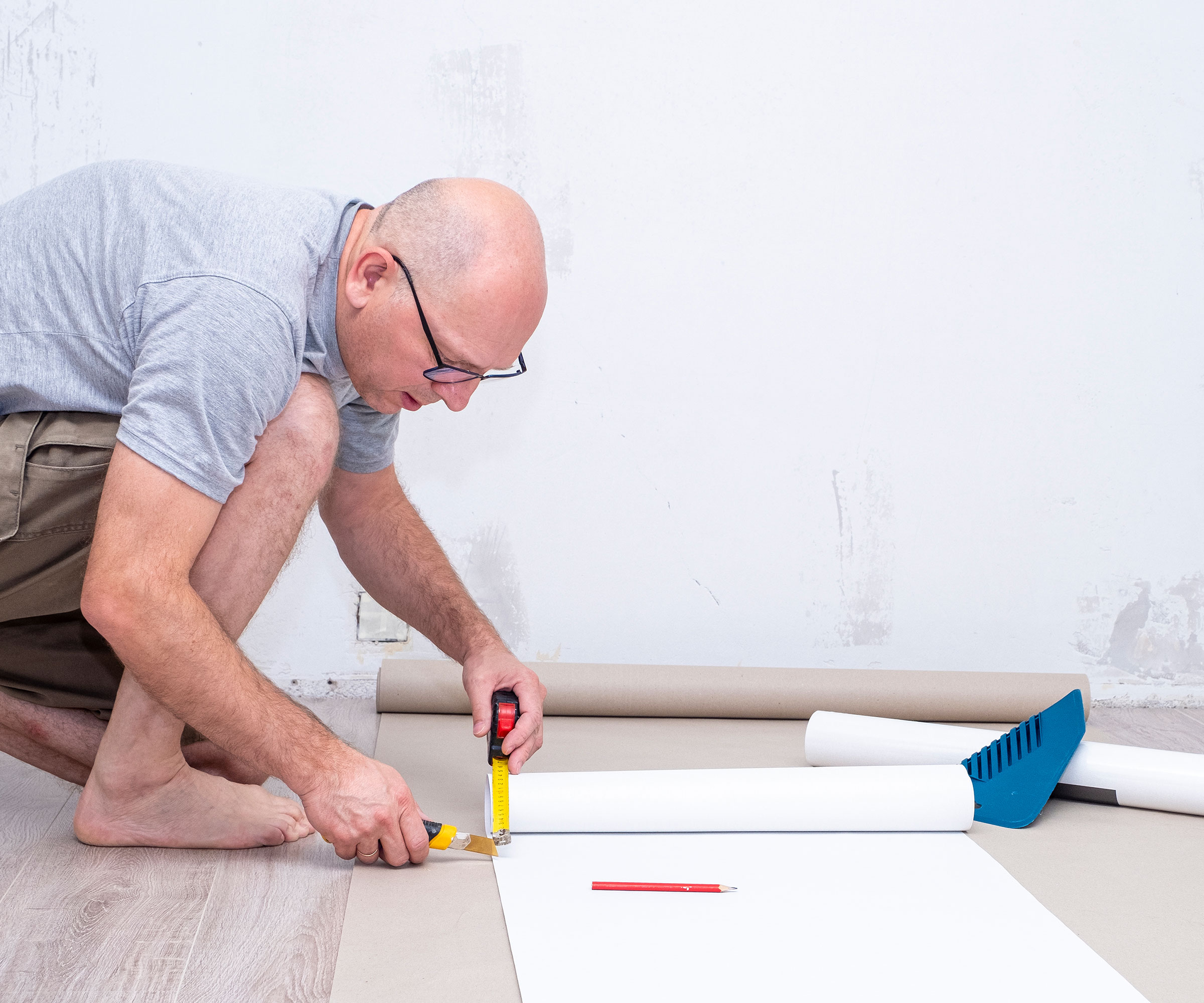
Just as when exploring how to tile a small bathroom floor, the task of wallpapering a small bathroom is, in some respects, easier than working with a large space due to the fact that you will have fewer walls to cover. That said, there will also be a few additional challenges, such as the fact that you might find yourself needing to make more cuts.
Start by measuring the drop of your first wall and add on a couple of inches on the top and bottom where you will trim the paper after it has been hung.
Cut the paper using wallpaper scissors, such as the Qualconnect 11 inch Wallpaper, Fabric Scissors from Amazon. As you are working in a small space it will probably be easier to measure and cut in a different room to avoid standing on your paper.
Step 4: Mark your starting point
Before you can start putting your paper up, you need to mark a perfectly straight vertical line on the wall where you will hang your first wallpaper strip. The line needs to sit the width of your wallpaper strips away from your starting point — so if your paper is fairly standard at 500mm wide, the line should be made 500mm away.
Use a laser line or spirit level to make sure it is totally straight. Ideally you want to start hanging in one corner, on a wall with no doors or windows, although this won’t always be possible in a small room.
That said, if your wallpaper ideas involve using a paper with a bold pattern, start in the center of the wall and work outwards.
Step 5: Hang your wallpaper

This next step will very much depend on the type of wallpaper you are using — paste-the-wall or paste-the-paper.
With paste-the-wall paper, following the manufacturer’s instructions, apply the adhesive directly to the section of wall you are about to cover using a roller. Then offer up your strip of wallpaper, lining it up with the pencil line you marked on the wall, adjusting while the paste is still gummy enough to allow movement.
If you are using paste-the-paper wallpaper you should apply the adhesive directly to the paper, working from the center outwards, using a pasting brush — this paste brush from Amazon is easy to use.
You will then need to fold the paper in on itself concertina style so that the pasted sides are resting on one another, and allow the paste to soak into the paper a little. You can then offer it up to the wall in the same way as for paste-the-wall paper.
In both cases, once you are happy with the positioning of the paper, use a wallpaper brush, a clean roller, or simply the flat of your hand to smooth out the paper and remove any air bubbles.
Step 6: Work around the corners
At some stage you'll probably meet a corner, unless you are only working on feature wall design ideas and are papering just one wall. You want to avoid two strips joining in a corner as it looks messy.
Measure from the edge of the last strip of paper up to the corner and add 30mm. Cut your wallpaper to this width and then hang it and brush the paper into the corner. You can then line your next strip up where the overhang ends and continue.
Step 7: Trim the top and bottom of the paper
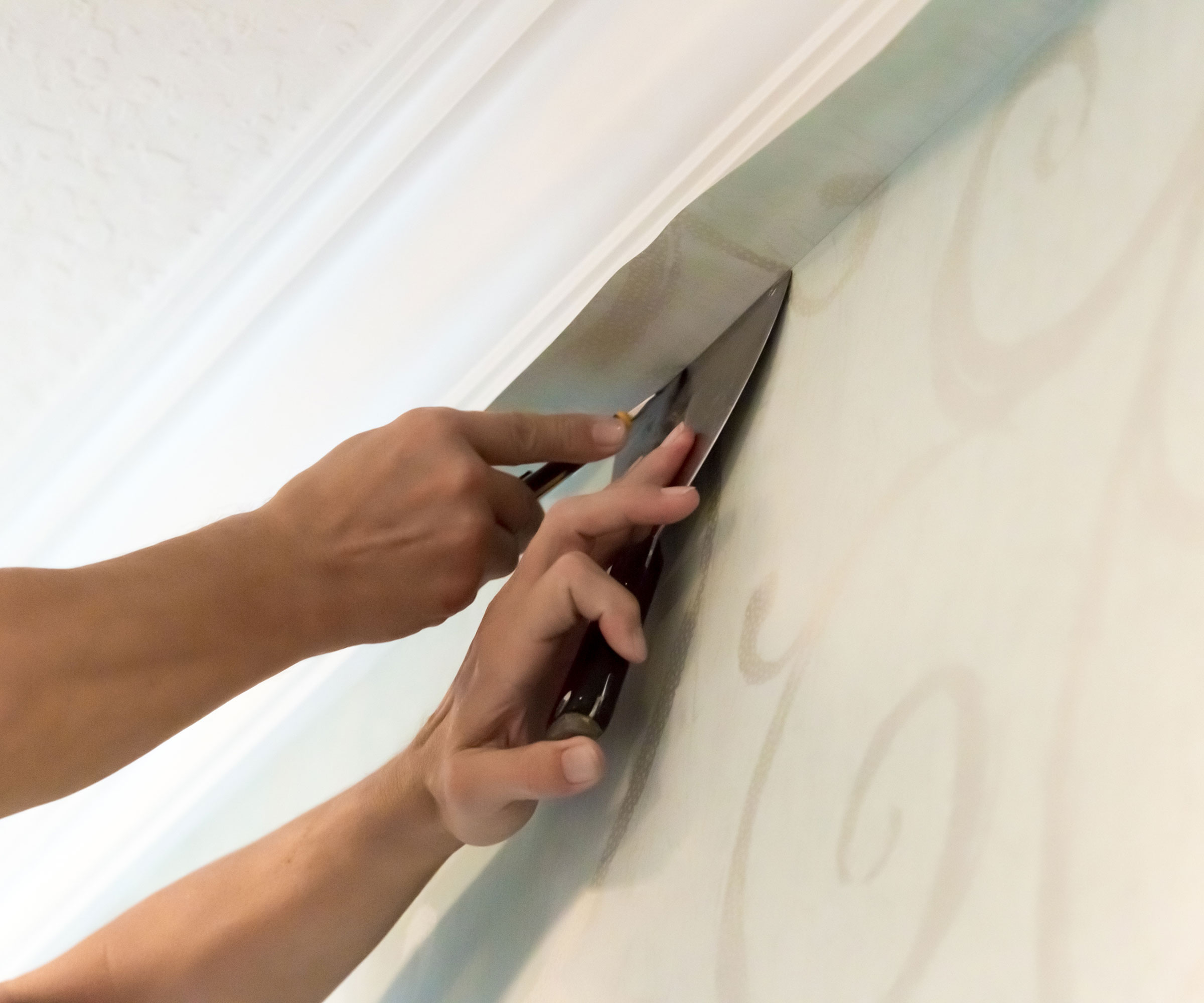
Push into the crease between the wall and the ceiling and the wall (or base board) using the back of some scissors or a steel ruler such as the Mr. Pen Steel Rulers from Amazon and use a sharp knife to cut off the excess.
Step 8: Finish up

Continue in the same way until you are finished. You will need to make cuts around doorways, windows and sockets and, if they can’t be removed, towel warmers or radiators. Check out some tips for wallpapering around awkward objects if you get stuck.
What to shop

Price: $69
This vinyl wallpaper has a beautifully serene pattern that would be perfect for any bathroom — but with its pale-colored design, it would work especially well in smaller spaces.

Price: $42.66
Perfect for bare drywall, this leaves walls ready to take wallpaper in just one hour. Even better, it is low-odor and easy to apply with little risk of splatter.
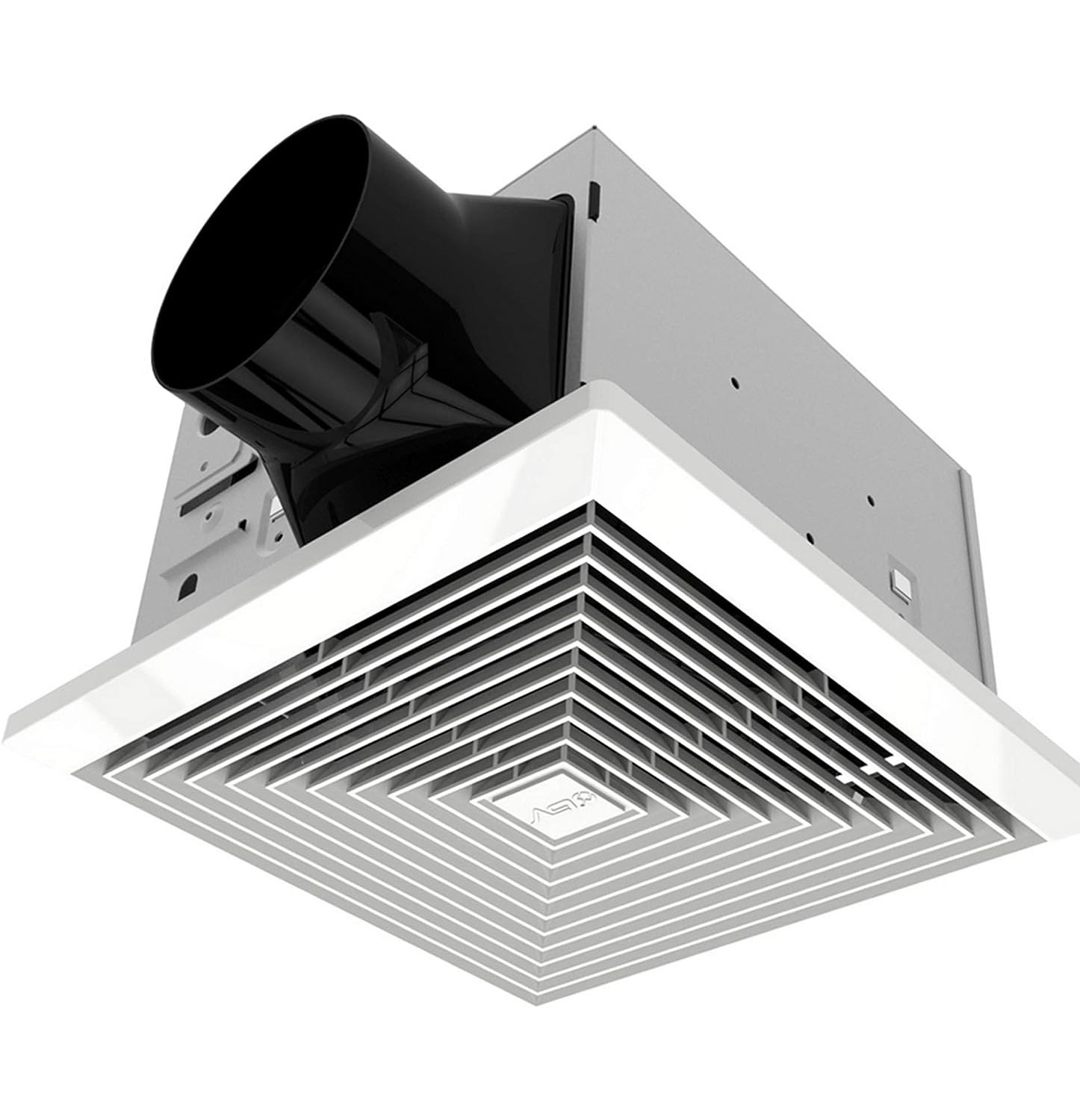
Price: $69
Perfect for keeping wallpapered bathrooms moisture-free, this exhaust fan is super quiet, yet really powerful – plus is it simple to install.
FAQs
What type of wallpaper is best for a bathroom?
You need to be really careful when it comes to getting your bathroom wallpaper ideas spot on that the products you choose are up to the job of handling the high moisture levels that will come their way, especially in a small bathroom.
"Look for wallpapers that are specifically designed for high-moisture environments, like vinyl or sealed paper," advises Giovanni Patania architect director at WindsorPatania Group. "These types are more resistant to peeling, fading and mildew, so they'll hold up better over time. You might also want to consider using a special adhesive or primer that's formulated for bathrooms, just to give your wallpaper some extra staying power."
Vinyl wallpaper is the best choice for humid environments as it is durable and resistant to moisture, explains Julianne Schaefer, interior designer and founder/principal at Collected Studio. She says, "For powder rooms (bathrooms without showers or bathtubs), standard paper can work well. These spaces are perfect for more delicate materials like hand-painted or hand-sewn wallpapers.”
"The only thing you must consider with this type of wallpaper is that this creates a non-breathable surface that acts as a vapor barrier," warns Corinne Segura, owner and consultant at My Chemical-free House. "This means that if you use AC inside your home and you have hot humid weather outside, this can create a dew point behind the wallpaper and cause mold to form behind it."
The vinyl wallcoverings from Burke Decor come in a huge range of colors and patterns.. She says "For powder rooms (bathrooms without showers or bathtubs), standard paper can work well. These spaces are perfect for more delicate materials like hand-painted or hand-sewn wallpapers.”
How do you prevent bathroom wallpaper from peeling?
There are a few ways to boost the longevity of your small bathroom wallpaper ideas.
"Keeping the bathroom’s ventilation in mind is really important. Having good air circulation is crucial when it comes to preventing moisture build-up, which can damage wallpaper over time," points out Courtney Cole, interior designer at Tile Cloud. "It might be worth considering installing a better exhaust fan and it's definitely a good idea to start giving your existing one a good and regular clean."
"It’s important in bathrooms to use a wallpaper paste designed for humid conditions, preferably one that is mold and mildew resistant," advises Courney Cole. "Being specially made to resist moisture it helps reduce the risk of peeling or mold development - making sure your wallpaper will look lovely and secure over time."
The Multi Purpose Wallpaper Adhesive Paste from World of Wallpaper is mold resistant and is suitable for most types of wallpaper.
Should you seal bathroom wallpaper?
If you have chosen not to use a vinyl or sealed wallpaper, you could well benefit from giving your paper a coat of sealer.
"There are two types of wallpaper that can be used in a bathroom, the first is paper-based and this should not be used 'as is' in a bathroom that has a shower or tub," says Corinne Sugura. "A way to make this type moisture-resistant is to coat the paper-based wallpaper with a clear varnish to protect it and use clear silicone caulk (such as the GE Silicone 1 Tub and Tile, Kitchen and Bath Clear Silicone Caulk from Lowes) at the edges."
What wallpaper makes a small bathroom look bigger?
As well as understanding the best ways to hang wallpaper in a small bathroom, it is also important to choose a color or print that will work well to make the most of the space from a visual perspective to ensure your bathroom ideas are everything you hoped for.
"In small spaces, the colors you pick can make a big impact on how you perceive the size of the room," explains Courtney Cole. "I usually recommend going for lighter colors like whites, grays, beige or light pastels to make the room feel bigger because they help reflect light around more.
"If you prefer dark colors I'd suggest using them as accents or for trim in the room, because this will keep the eye moving around the room and won’t absorb light like completely decorating with dark wallpaper will.”
"I tend to prefer light colors such as pale blues, soft greens, light grays and whites, which can help to make a small bathroom feel larger and more open," agrees Alice Moszczynski, interior designer at Planner 5D. "Avoid dark colors, as they can make the space feel cramped. As for patterns, subtle designs like delicate florals, small geometric shapes, or textured patterns can add interest without overwhelming the space."
Not everyone agrees, however...
"Bold colors and patterns are excellent choices for smaller bathrooms," says Julianne Schaefer. "In compact spaces, don't be afraid to go big and make it your own jewel box. Hand-painted or hand-sewn wallpapers can add a unique and luxurious touch.”
"Larger scale bold floral wallpapers are a great choice for making a small bathroom feel larger and choosing a dark rich color will add extra depth to your space," agrees Rebecca Drury, co-founder of MissPrint. "It is a misconception that dark colors will make your room feel smaller. Bathrooms are often the smallest room in a home and a great space to have some fun with pattern and colour!"
Malmberg Peel & Stick wallpaper by Three Posts from Walmart features a strong pattern of botanicals and florals that would really pack a visual punch in a small space.
Meet the experts

In her first career Julianne worked in the buying office for Macy's Inc, where she she acquired a strong business acumen and inspiration to launch her own business. Eventually Julianne pursued a new career path as an interior designer where she was able to combine her business background with her love of design and beauty. Julianne worked for several architectural firms including Gensler and Smithgroup, and consulted for some of the top luxury residential firms in the San Francisco Bay Area before founding Collected Studio.
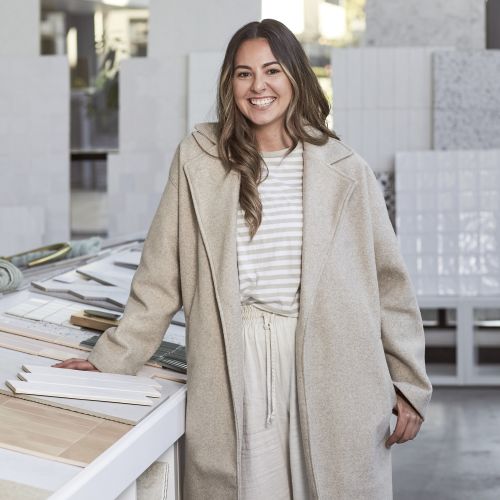
Courtney is an interior designer at TileCloud and sister company Yabby. She brings a wealth of knowledge and expertise to the world of home renovation. With a Diploma in Interior Design and Decoration and a passion for creating stunning interiors, she's dedicated to helping people on their journey to transform their home
There are so many ways to finish off the walls of your small bathroom and while wallpaper is a great way to inject a little character and individuality into the space, you might also like to consider a few small bathroom wall paneling ideas alongside, your choice of paper or paint.
